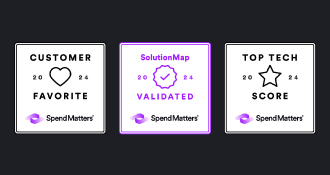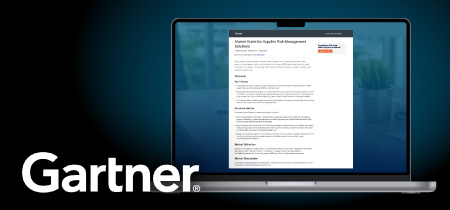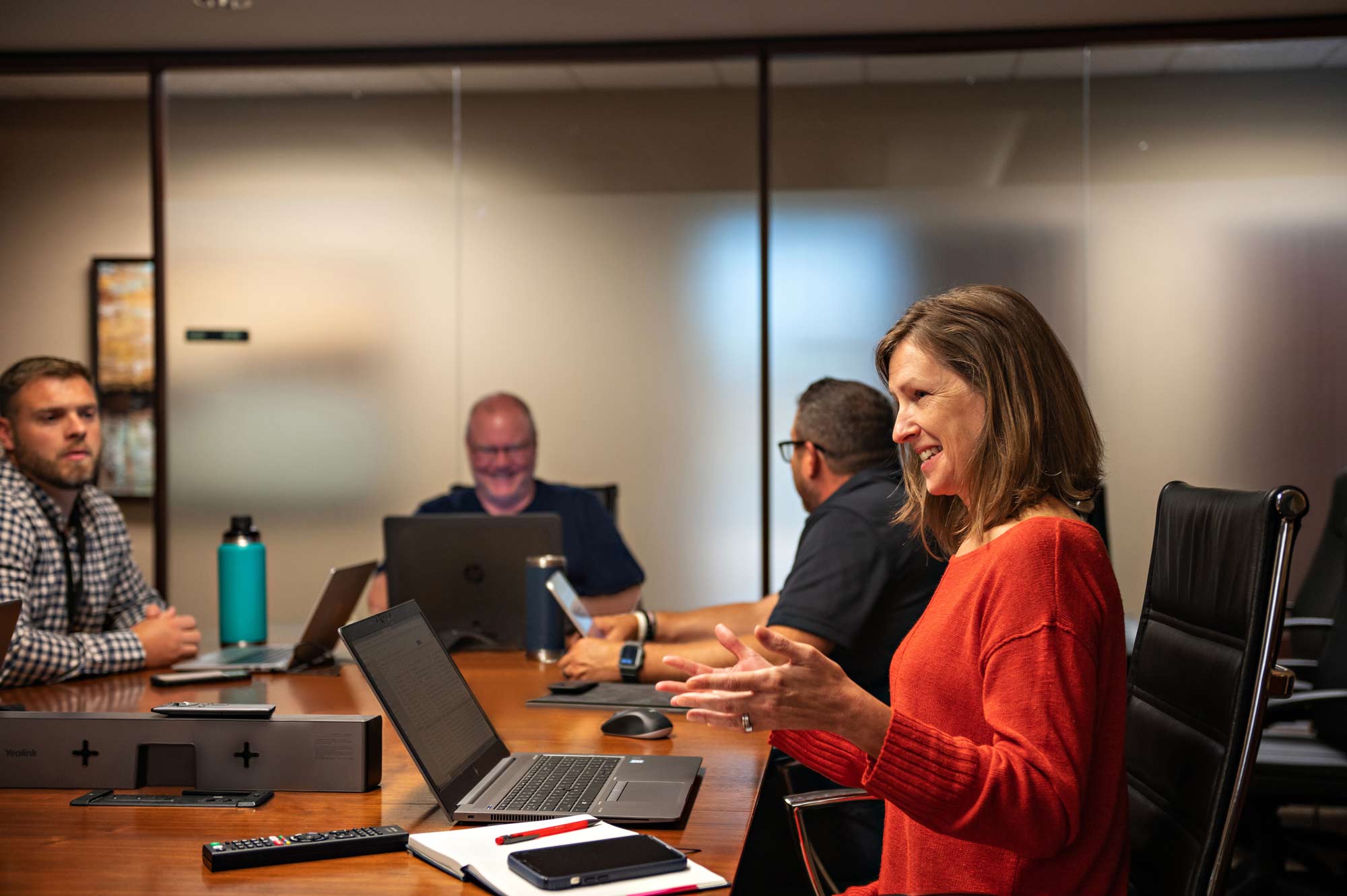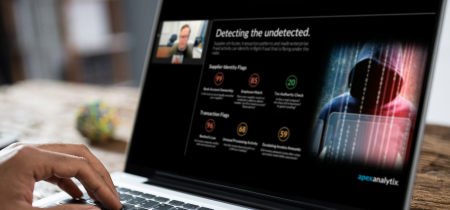How does a procure-to-pay recovery audit, revealing and recovering duplicate payments, statement credits and overpayments outside of ERP controls help The Mosaic Company protect profit? Laureen Stephens, AP Manager for EBS/North America Shared Services tells us how procure-to-pay errors occur in the normal course of running a $19B mineral production business and why she is committed to recovering overpayments before they are lost forever. Want to hear Laureen’s story? Listen to the recorded webinar.
Laureen, you used to have an internal team focused on finding overpayments. Why did you change strategies?
Laureen: Yes, we had five people who focused on reconciling supplier statements. We used a combination of staff and contractors. While it was a valuable process, it was time-consuming, not a primary focus for the AP organization, and not the specific skillset of the team. We realized that the skill and time of some of these team members could be directed to more value-added AP and P2P activities. So when we changed to a shared services model, we dissolved the statement reconciliation team and eliminated the need for contractors to support the statement reconciliation process.
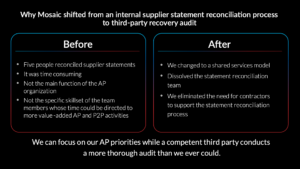
A graphic showing the benefits they got when they outsourced their recovery audit to apexanalytix.
Pete, what’s the right balance of internal and external procure-to-pay transaction review for overpayments?
Pete: For vendor credits, I recommend that internal teams focus on statement credits in the 90 days after the payment. It is a manageable time frame for the AP team to resolve open credits, while also making sure that they are doing the priority work: paying vendors according to terms, meeting key performance indicators (KPIs) and managing communications with suppliers. But once that 90 days is over, apexanalytix can come in and start our process, one that has been refined for 35 years, to find duplicate payments, statement credits and other overpayments that haven’t been identified or recovered.
Laureen, what was the scope of your last completed audit?
Laureen: We did an audit that included disbursements for the US, Canada and LATAM. Our ERP system is SAP. The apexanalytix audit team reviewed 2.5M invoices, expenditures of $19.5B, credits aged over 90 days, for 2,318 suppliers. There were 293 recoveries totaling $1.8 million that went right back to the bottom line. The scope included duplicates and statement credits but we are looking at other audit areas in the future.
Pete, what is the scope of a basic AP recovery audit and what are some of the other areas that you have reviewed for clients?
Pete: A basic review includes three areas:
- Duplicate and erroneous payments, where we analyze invoice and payment data to identify overpayments.
- A supplier statement review, which is more involved. We engage suppliers to identify and recovery client funds found on suppliers’ books but not known to clients.
- And we do a debit balance review, where we engage suppliers again, this time with the objective of finding recovering funds that are in a debit balance on client books..
Four other areas of audit that we can perform are:
An uncashed check review, in which we research uncashed checks to identify those that don’t require escheatment to U.S. government authorities.
An unclaimed property review, that involved review of states’ and other local jursidictions’ databased for client funds escheated by other parties and owed to our client.
Contract and pricing compliance reviews, where we compare contract terms and related transactions to identify non-compliance and recover associated overpayments.
And a sales and use tax review that looks at sales transactions and use tax returns to identify overpayment of taxes according to taxability rules for products and services.
The cool thing is, once we have a relationship with a client for an AP audit, and their transactional data it makes it easy to move into other areas of value. For each of these, we have distinct practice under the leadership of professional experts in each audit area.
Laureen, why contract with apexanalytix for recovery audit?
Laureen: There are a few reasons this makes sense for us:
- We don’t pay apexanalytix unless they recover money. So it is an easy sell to senior finance leadership.
- Apexanalytix is an expert at recovery audits. By allowing a third-party to complete the audit for us, especially one that has a proven process, it makes sense and then allows the AP team to focus daily processes and other needs.
- They find things that AP doesn’t know or can’t know about, specifically on the supplier’s side, as we do not have access into their processing.
What do you mean by that?
Laureen: apexanalytix’s audit team works directly with suppliers. You may be surprised at how many times something is on the supplier’s books that isn’t on our books. It could be because of a pricing versus invoice error, a return, overpayments related to a material PO or a service PO, or a unit of measure error – a tonnage issue that leads to a unit of measure overpayment, for example.
Pete, how does apexanaltyix get to all the recoveries?
Pete: We call our method “People Empowered With Technology.” Think about this: Laureen has 2,318 suppliers. That’s 2,318 back-and-forth communications to ask for a statement, get a current statement, identify if credits exist, verify the credit, get the supplier agreement, and post the recovered amount. We reach out to them through a process that combines calling, emailing, and most importantly, a workflow that takes care of follow up. We also use intelligence to identify credits on statements. I challenge any other recovery audit company to be able to manage communications with suppliers more efficiently. It’s a process that the supplier appreciates and gets the client money faster. Sometimes people forget that an overpayment is a financial error on the books of the supplier. They want to clear it up as timely as possible. Nothing is worse for a supplier than to have to issue a credit months after the transaction. And nothing is worse for the client than money that should have been profit but is gone forever because a supplier can’t be reached to confirm the recovery.
Four things are unique assets apexanalytix has when we perform an AP recovery audit.
- We have application developers on staff who have worked with our statement and duplicate audit teams to create workflows and technology that identifies potential overpayments and credits and speeds up communications and recovery efforts.
- We have sophisticated scoring algorithms in all our products and services
- apexanalytix has built the “supplier database of supplier databases” (90 million supplier golden records, scored for accuracy, opportunity and age), so our audit team has access to supplier contact information that even our clients often don’t have.
- Our firststrike overpayment software for duplicate identification and prevention has been around since the mid-90s, and has been continuously enhanced by input from clients, and the input from some of harshest critics of all, our internal team of auditors.
Laureen, Pete’s explained what his side has to do to complete the recovery, how about The Mosaic Company? What kind of time commitment is there on your part?
Laureen: I have a recommendation for other companies on this topic. Give apexanalytix what they need so they can work as independently as possible. They have an automated data extraction process for SAP, so that’s easy. They get the transactional data they need for the duplicate review right at the start. And once we decide on the scope – the suppliers to be included in the audit – they get to work right away with the outreach based on the supplier list we provide. We go a step further and gave apexanalytix a secured laptop with read-only access into our SAP system so they can research the claims on their own. This way they can do nearly 100% of the work themselves, and even get the authorization from the supplier to make the final deduction.
One of the best parts of the audit is the apexportal auditview application. Every single claim in progress, updated in real time, is there for me to see. I use this to watch the progress of the audit. And when apexanalytix has a question or is having any problem resolving an issue, we are looking at the same information together to work on the solution.
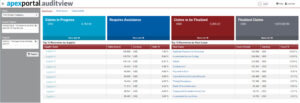
A screenshot of the apexanalytix apexportal auditview application.
Laureen, do you have any other advice for companies considering an audit recovery or a procure-to-pay review?
Laureen: If you have had any changes in our AP process or systems, like the one we are going through now, don’t wait to do a recovery audit. An audit on your past AP transactional data will give you not only the recoveries, but you’ll have an AP benchmark of your payment process. You have the potential to uncover possible control weaknesses in procure-to-pay, in areas like returns, receiving, procedural errors in AP, and much more. And then, once you’ve gone through the upgrade, consolidation, or whatever change is happening in your world, you should do another recovery audit. We are looking forward to comparing the audit results to see what we need to correct and improve upon, within AP, and with our partners in procurement. And of course, we look forward to the return of the recovered dollars.
Pete, any closing thoughts on your part?
Pete: Just an invitation to any company out there who is disbursing billions of dollars to give apexanalytix a try. I’ve been here for 24 years, and the progress I’ve seen in the industry and in our approach to audit has kept me excited about how we can help AP leaders like Laureen make a real difference for their companies.
Interested in learning how an apexanalytix recovery audit can benefit your company? Contact us now to start the discussion.

About Laureen
Laureen D. Stephens is Accounts Payable Manager – EBS/North America Shared Services for The Mosaic Company, a global leader in the crop nutrient industry. She has 30+ years of management experience ranging in various fields such as medical, retail and banking. She is from Bloomington, Minnesota, but now lives in the sunny state of Florida. She sings in her choir at church as well as in a women’s trio ensemble and has traveled with both in ministry. Laureen has two daughters who are both married; she is blessed with three wonderful grandchildren who adoringly call her “LaLa”.
The Mosaic Company is one of the world’s leading producers and marketers of concentrated phosphate and potash crop nutrients. Mosaic is a single source provider of phosphate and potash fertilizers and feed ingredients for the global agriculture industry. More information on the company is available at www.mosaicco.com .

About Pete
As Vice President, Commercial Audit Operations, Pete leads the apexanalytix commercial audit division and works directly with clients on strategic audits. His team is responsible for the oversight, management, and client satisfaction of commercial audit engagements. His goals are to ensure audits are completed in a timely manner, that they meet or exceed revenue expectations and performance objectives, and they deliver client value in recovered monies and enhanced internal controls. Pete has been in Operations for over 24 years, the past 20 in management. Prior to joining APEX, Pete’s career experience includes public accounting, tax preparation and auditing. Pete holds a BA in Corporate Communications with a Business Administration Minor from Elon University. Pete is also a Certified Public Accountant and a member of the AICPA, NCACPA, IIA.
apexanalytix is a pioneer in the supply chain software, data, and analytics markets with data-powered software and services for supplier management, fraud prevention, and overpayment recovery. Today, apex serves over 250 Fortune 500 and Forbes Global 2000 companies, protecting more than $9 trillion of annual spend across the world’s most complex supply chains. apex’s leading suite of products includes its supplier management platform, which fully automates supplier on-boarding, master data management, and continuous monitoring of supplier and supply chain risk, throughout the supplier life cycle.

